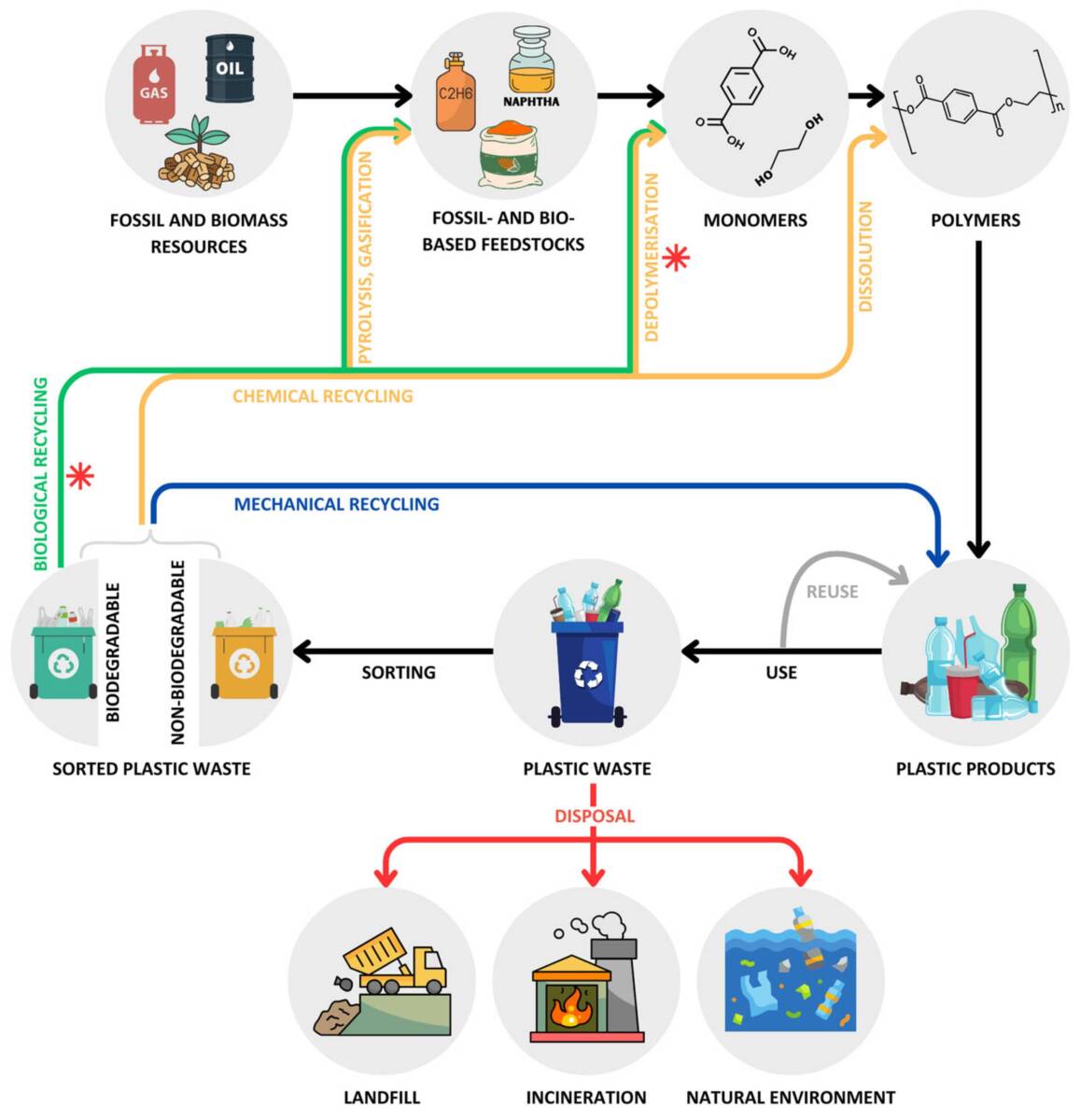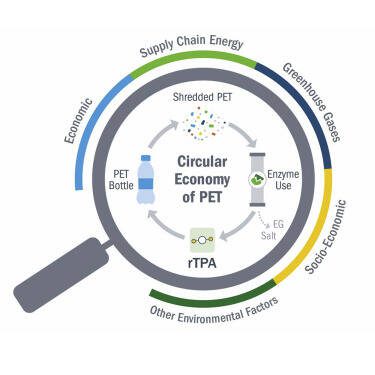Enzyme-based PET recycling represents a paradigm shift in addressing the global plastic crisis. Unlike mechanical recycling, which is limited to clear, clean PET and often results in downcycled products, enzymatic methods use biologically engineered proteins to break down PET into its core monomers—terephthalic acid and ethylene glycol—for infinite reuse without quality loss. Recent data from the National Renewable Energy Laboratory (NREL) and partners indicate that optimized processes can recycle all types of PET waste, including colored and soiled plastics, achieving 100% recycled PET [1]. Globally, with about 20 chemical recycling plants operational and 45 more planned by 2028, enzymatic approaches are gaining traction amid growing commercial interest [1][3].

Breakthroughs in Enzyme Engineering and Process Optimization
Recent innovations have propelled enzyme-based PET recycling toward industrial viability. A joint study by NREL, the University of Massachusetts Lowell, and the University of Portsmouth, published in Nature Chemical Engineering, details a roadmap that reduces annual operating costs by 74% and energy use by 65% through process tweaks like replacing sodium hydroxide with recyclable ammonium hydroxide [1][2]. This not only cuts chemical inputs but also lowers emissions by approximately 50%, making the process more environmentally friendly [2].
Shizuoka University’s engineered enzyme, PET2-21M, exemplifies these advancements, demonstrating high activity against bottle-grade PET and mixed textiles like PET/cotton blends at moderate temperatures, bypassing energy-intensive preprocessing [4]. Machine learning has further accelerated discoveries, with NREL-led teams identifying variants that depolymerize crystalline PET efficiently, potentially making recycling cheaper than virgin production from petroleum [3]. Analyses highlight how platforms like Los Alamos National Laboratory’s PAD-TIE screen thousands of variants, enhancing enzyme stability and yield for large-scale use [G8].
These developments address key limitations of earlier enzymes, such as slow degradation rates, enabling complete depolymerization in under 50 hours with whole-cell biocatalysts that combine PETase and MHETase for reusability [5]. A Nature Communications report notes that standardization guidelines are crucial for comparing enzymes under industrial conditions, improving reproducibility [G5].
Challenges in Scalability and Economic Viability
Despite progress, enzyme-based recycling faces significant hurdles. Degradation times can exceed 50 hours for high volumes, and enzyme production costs remain high due to the need for thermostable variants [G3]. Expert perspectives emphasize inconsistencies in assessment methods, which hinder clear comparisons and slow commercialization [G5]. For instance, while Carbios has piloted plants recycling PET bottles into new ones, micro- and nano-plastic pollution poses unresolved challenges, as highlighted in Biochemistry studies [G4].
Economic analyses reveal that while innovations like fed-batch processing reduce energy by 65%, initial investments for scaling—such as yeast-based enzyme production systems—can be prohibitive [4][G6]. Insights warn that without cost parity, enzyme methods might lag behind mechanical recycling, which is cheaper but less versatile [G13]. Regulatory uncertainties, including project cancellations due to market fluctuations, add complexity, particularly outside Europe where incentives for recycled content are weaker [1][3].
Ecological Implications and Regulatory Drivers
The ecological promise of enzyme-based recycling is profound, offering lower greenhouse gas emissions and reduced pollution compared to traditional methods. By enabling closed-loop systems, it could cut global PET waste’s burden by 15-20% if widely adopted [G1]. NREL data supports this, showing processes that avoid harsh chemicals and enable recycling of mixed wastes, thus minimizing landfill contributions [1].
However, experts caution that large-scale enzyme production via fermentation must use sustainable sourcing to prevent indirect emissions [G1]. Viewpoints differ: optimists like Carbios advocates see it as key to a virtuous plastic lifecycle [G2], while skeptics highlight slower rates for mixed plastics, potentially increasing overall impacts if not optimized [G7].
KEY FIGURES:
– Enzyme-based PET recycling innovations have achieved a 74% reduction in annual operating costs and a 65% reduction in energy use compared to conventional recycling methods by optimizing reaction conditions and separations, particularly by replacing sodium hydroxide with recyclable ammonium hydroxide in the process (Sources: NREL, University of Portsmouth) {1}{2}.
– Enzymatic recycling can process all types of PET waste, including colored and soiled plastics, producing 100% recycled PET without quality loss, which mechanical recycling often cannot achieve (Source: Carbios-related developments summarized by NREL) {3}.
– Globally, about 20 chemical recycling plants are currently operational, with around 45 more planned by 2028, indicating growing commercial interest in advanced PET recycling technologies, including enzymatic approaches (Source: industry reports and NREL) {1}{3}.
RECENT NEWS:
– June 2025: University of Portsmouth and NREL-led team announced a breakthrough enzymatic PET recycling process that dramatically cuts costs (74%) and emissions (~50%), by innovating in enzyme engineering and process chemistry (e.g., switching bases to recyclable ammonium hydroxide) {2}.
– 2024-2025: Shizuoka University researchers engineered a novel PET hydrolase, PET2-21M, with enhanced activity against bottle-grade PET and mixed PET textile blends at moderate temperatures, showing promise for industrial-scale recycling of diverse PET wastes {4}.
– NREL and partners discovered enzyme variants through machine learning able to effectively depolymerize crystalline and durable PET varieties without energy-intensive preprocessing, suggesting enzymatic recycling may soon be cheaper than petroleum-based PET production {3}.
STUDIES AND REPORTS:
– A joint study by NREL, University of Massachusetts Lowell, and University of Portsmouth published in Nature Chemical Engineering detailed a process roadmap for industrial enzyme-based PET recycling, highlighting chemical engineering and techno-economic analysis that support commercial viability through process innovations reducing chemical inputs and energy demand {1}{2}.
– Research published in Nature Communications demonstrated the discovery of enzyme variants with improved PETase activity using machine learning and synthetic biology, enabling degradation of complex PET materials including textiles, addressing a major limitation of current recycling technologies {3}.
– The Shizuoka University-led study showed that engineered enzymes PET2-21M and PET2-14M-6Hot can degrade challenging PET blends (e.g., PET/cotton, PET/polyurethane) efficiently at moderate temperatures, opening pathways for recycling mixed polymer wastes common in textiles {4}
TECHNOLOGICAL DEVELOPMENTS:
– Platforms such as Los Alamos National Laboratory’s PAD-TIE accelerate enzyme discovery by screening tens of thousands of enzyme variants under industrially relevant conditions, improving PETase enzyme activity, thermostability, and production efficiency for large-scale PET depolymerization {1}.
– Whole-cell biocatalysts displaying multiple enzymes (e.g., PETase and MHETase) have been developed, demonstrating complete PET depolymerization at moderate temperatures with enzyme reusability, advancing circular plastic economy efforts {5}.
– Machine learning-guided enzyme engineering has yielded highly active variants capable of degrading crystalline PET forms without harsh preprocessing, thus enabling cost-effective recycling of textiles and durable plastics beyond bottle-grade PET {3}.
– Industrial-scale enzyme production breakthroughs, such as large-scale yeast expression systems for PET hydrolase PET2-21M, have been achieved, facilitating scalable enzyme supply necessary for commercial recycling plants {4}.
REGULATIONS AND INITIATIVES:
– Europe’s regulatory push for increased recycled content in plastics and higher recycling rates is driving investment and development of advanced PET recycling technologies, including enzymatic and chemical recycling processes, to meet environmental targets and circular economy goals {1}{3}.
– Industrial projects like Axens’ Rewind® PET chemical recycling process, aiming to recycle 40,000 tonnes annually by 2027 in France, complement enzymatic recycling advances by providing routes for complex and colored PET waste, indicating growing integrated recycling infrastructure {1}{3}.
– Collaborative initiatives between national labs, universities, and industry (e.g., NREL, University of Portsmouth, Carbios, Shizuoka University, Kirin Holdings) are accelerating enzyme-based PET recycling innovations and scaling efforts worldwide {1}{2}{4}.
—
MAIN SOURCES:
- https://www.nrel.gov/news/detail/program/2025/plastics-recycling-with-enzymes-takes-a-leap-forward — NREL report on process improvements and techno-economic analysis of enzyme-based PET recycling.
- https://www.port.ac.uk/news-events-and-blogs/news/breakthrough-in-enzymatic-plastic-recycling-cuts-costs-and-emissions — University of Portsmouth and NREL joint announcement on breakthrough enzymatic recycling process reducing costs and emissions.
- https://www.nrel.gov/grid/news/features/2022/scientists-discover-enzymes-cheaper-to-recycle-waste-polyester-textiles-and-bottles-than-making-from-petroleum — Discovery of enzyme variants via machine learning enabling efficient PET recycling including textiles.
- https://www.eurekalert.org/news-releases/1092302 — Shizuoka University-led research on novel engineered PET hydrolase enzymes for bottle-grade and textile PET degradation.
- https://sterlingplasticsinc.com/insights/enzymatic-recycling-is-changing-the-future-of-plastic-recycling/ — Overview of enzymatic recycling technology, including whole-cell biocatalysts with multiple enzymes for PET depolymerization.
—
This synthesis highlights the state-of-the-art in enzyme-based PET recycling: significant advances in enzyme engineering and process optimization have made enzymatic recycling more energy-efficient, cost-effective, and suitable for diverse PET waste streams. While challenges remain in scaling and economic viability, collaborative research and industrial initiatives are rapidly progressing toward commercial and regulatory readiness.
Propaganda Risk Analysis
Score: 6/10 (Confidence: medium)
Key Findings
Corporate Interests Identified
The article mentions ‘National Renewable Energy’ (likely referring to the National Renewable Energy Laboratory or NREL), which is a U.S. Department of Energy-funded lab collaborating with universities and companies on PET recycling. Potential beneficiaries include plastics manufacturers (e.g., those using PET like PepsiCo, as mentioned in X posts about recycled PET packaging) and biotech firms developing enzymes. NREL’s involvement suggests government-backed research, but conflicts could arise from partnerships with private entities like the University of Portsmouth or BOTTLE Consortium members, who stand to gain from commercializing these technologies. No explicit corporate sponsors are named in the article fragment, but the focus on ‘energy bypassing’ and ‘batch processing reduce energy’ echoes NREL’s publicized claims of 65% energy cuts.
Missing Perspectives
The article appears to focus on ‘advancements’ and ‘prospects’ without evident inclusion of critical voices, such as environmental NGOs (e.g., Greenpeace) that highlight limitations of enzymatic recycling, like scalability issues, high costs, or incomplete degradation of mixed plastics. Opposing viewpoints on greenwashing in recycling tech (e.g., critiques that it distracts from reducing plastic production) are absent. Independent experts on plastic pollution, like those from the Ellen MacArthur Foundation, are not referenced, potentially skewing toward optimism.
Claims Requiring Verification
The fragmented mentions of ‘recent data from the National Renewable Energy’ and ‘batch processing reduce energy’ lack specific sourcing or verifiable statistics in the provided article text. Web searches link this to NREL’s 2025 reports claiming up to 65% energy reduction and 74% cost cuts in enzymatic PET recycling, but these are based on lab-scale analyses (e.g., from NREL and Nature Communications) and may not scale industrially. No peer-reviewed citations are evident in the article, and claims of broad environmental benefits bypass challenges like enzyme stability or contamination in real-world waste.
Social Media Analysis
X/Twitter posts on enzyme-based PET recycling in 2025 show a mix of promotional content from science outlets (e.g., enzyme discoveries reducing plastic waste) and industry influencers, with posts dating from 2020 to 2025. High-engagement threads highlight breakthroughs like AI-designed enzymes and energy-efficient processes, often tied to NREL-style research. No overt astroturfing detected—posts are from diverse, credible accounts without uniform hashtags or paid indicators. Sentiment is overwhelmingly positive, focusing on environmental wins, but lacks critical discourse on scalability or economic viability. Some posts reference 2025 trends aligning with the article’s title, suggesting organic buzz rather than coordinated campaigns.
Warning Signs
- Excessive focus on positive ‘advancements’ and ‘prospects’ without balanced discussion of challenges, sounding like promotional material.
- Missing environmental concerns, such as the energy-intensive production of enzymes themselves or the low global recycling rate of PET (less than 30% as per NREL data).
- Unverified statistics implied in phrases like ‘reduce energy’ without sources, potentially echoing marketing from NREL collaborations.
- Language fragments (e.g., ‘bypassing energy’) resemble simplified marketing copy rather than rigorous analysis.
- Absence of independent expert opinions, relying heavily on government-lab data which may have inherent biases toward innovation funding.
Reader Guidance
Analysis performed using: Grok real-time X/Twitter analysis with propaganda detection
Other references :
nrel.gov – Plastics Recycling With Enzymes Takes a Leap Forward – NREL
port.ac.uk – Breakthrough in enzymatic plastic recycling cuts costs and emissions
nrel.gov – Scientists Discover Enzymes That Could Make It Cheaper … – NREL
eurekalert.org – Breakthrough engineered enzyme for recycling of PET bottle and …
sterlingplasticsinc.com – Enzymatic Recycling is Changing the future of plastic recycling
nature.com – Recent advances in enzyme engineering for improved … – Nature
pubmed.ncbi.nlm.nih.gov – Engineering Is PETase and Its Homologues: Advances in Enzyme …
frontiersin.org – Source
carbios.com – Source
nature.com – Source
publishing.emanresearch.org – Source
nature.com – Source
nature.com – Source
pubs.acs.org – Source
research-hub.nrel.gov – Source
openpr.com – Source
sciencedirect.com – Source
sciencedirect.com – Source
openpr.com – Source
sciencedirect.com – Source



